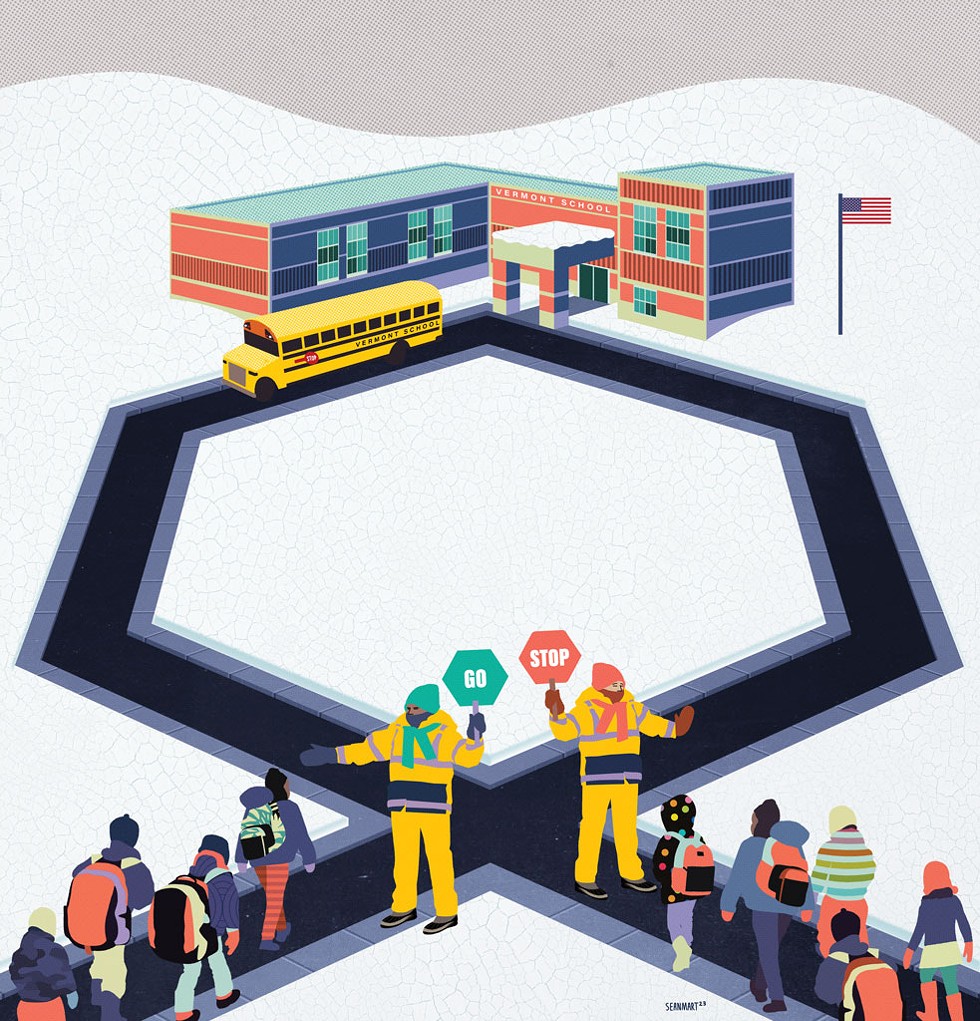
- Sean Metcalf
Driving all three situations is an ambitious and unprecedented plan, mandated by the legislature, to test more than 300 older schools across the state for airborne PCBs, or polychlorinated biphenyls. The compounds were once commonly used in commercial building materials such as window caulk, paint and tile glue. PCBs were outlawed in 1979 because of the harm they cause to humans and the environment.
Vermont began testing in June, using standards set by the state Department of Health that are much stricter than the federal ones. If deemed at risk, schools must embark on an expensive and time-consuming mission to identify and remove the sources. Of 22 schools tested so far, eight have levels that require further action.
In a league of its own is Burlington High School, where officials discovered PCB levels above the state standards in 2020. The school's plight is what prompted the legislature to require statewide testing and local voters to approve a $190 million rebuild.
While lawmakers allocated $4.5 million for testing in 2021 and $32 million for remediation the following year, the full cost of addressing the PCBs is unknown. Nor is it clear whether or how much cash-strapped schools would have to contribute. That uncertainty has caused school superintendents to push back, arguing that it would divert funding from educational programs.
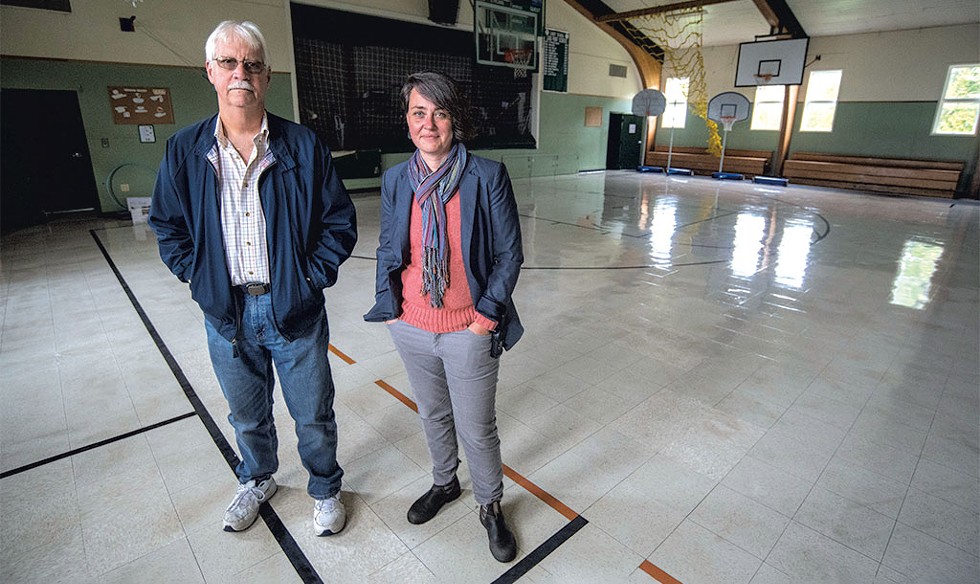
- File: Jeb Wallace-Brodeur
- Superintendent Mark Tucker and principal Rebecca Tatistcheff in the Cabot School gymnasium
With some schools facing large, nonnegotiable expenditures, legislators are asking hard questions about the program — most importantly, whether it should continue. Last Friday, the House Education Committee green-lighted a measure that would pause PCB testing and roll the program into a broader, evolving school construction initiative. That could defuse a potential financial crisis set in motion when the state adopted strict PCB standards and mandated the testing. But it won't assuage the public health concerns that sparked the testing in the first place.
House Education Committee chair Peter Conlon (D-Cornwall) said he believes pausing the program would allow the legislature to more thoughtfully integrate PCB testing with longer-term goals for Vermont's aging school facilities. Does it make sense, for example, to prioritize a costly PCB-remediation project in an old school that needs major renovations?
But Conlon's counterpart in the upper chamber, Senate Education Committee chair Brian Campion (D-Bennington), thinks questions like that miss the point of the testing program.
"When it comes to kids, I'm going to be on the side of caution," he said. "I want to make sure that kids are safe in these school buildings that they're going to every day."
As lawmakers are debating the issue, local school officials are paying close attention. Caledonia Central Supervisory Union superintendent Mark Tucker calls himself a "PCB pioneer" because the new testing program's first hit was in the gym of Cabot School, in his district. Subsequent tests, taken during the school year while the ventilation system was operating, returned lower PCB levels, and the room was reopened.
Seven months later, Tucker said, he still doesn't know how to fix the underlying problem. Adding to the challenge, he recently learned that two more Caledonia Central schools have levels in several rooms that will require remediation.
"Our students didn't put PCBs in the school buildings, and they didn't tell us to take them out," Tucker said. "Yet if some communities are forced to solve the problem by taking away funding from our education mission, it will be our kids who are paying the price."
'Canary in the Coal Mine'
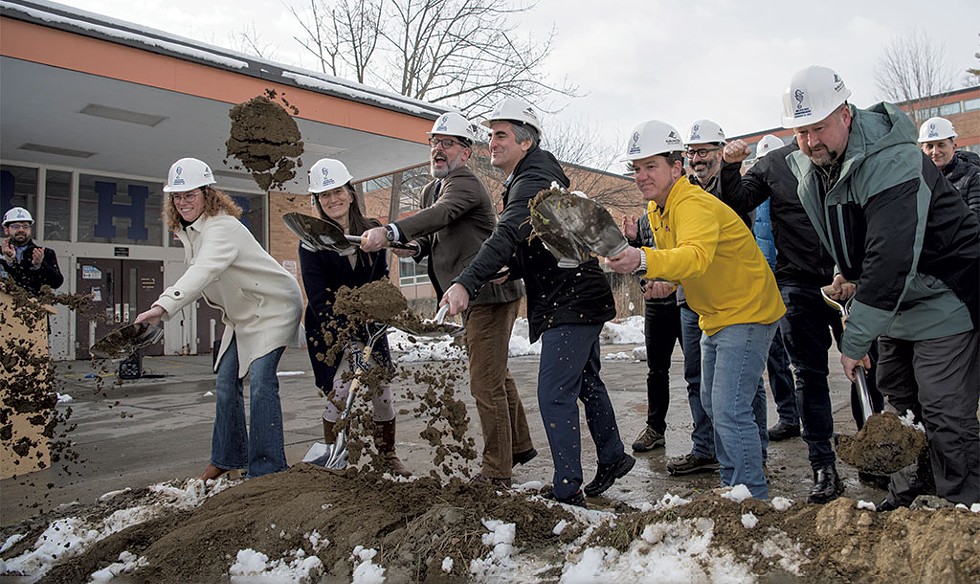
- Daria Bishop
- Burlington School District superintendent Tom Flanagan and Mayor Miro Weinberger (center) leading the "groundbreaking" for new construction
On March 15, district and city officials, school board members, and construction contractors gathered outside the former Burlington High School for what they described as a "groundbreaking."
VIPs grinned under ill-fitting commemorative hard hats that were emblazoned with the school's seahorse mascot. Some supporters held up signs that read "Our Future Is Bright" as superintendent Tom Flanagan, Burlington Mayor Miro Weinberger and others marked the beginning of a new chapter in the school's history.
In fall 2020, environmental testing undertaken in advance of a $70 million renovation project detected elevated levels of airborne PCBs in some of the high school's classrooms, including especially high concentrations in a building that housed the technical center's welding, construction and automotive classes.
That led to a cascade of decisions. Administrators, following health officials' guidance, shuttered the school. The district rented and revamped a former Macy's department store in downtown Burlington to serve as a temporary high school — albeit one with no kitchen, gym or auditorium, and with an annual rent of more than $1 million. Tech center programs were scattered in temporary spaces throughout the city.
Related Burlington High School Opens Downtown Campus in Former Macy's

At a March 2021 ribbon-cutting ceremony for the makeshift high school, Sen. Philip Baruth (D/P-Chittenden-Central) suggested that other schools could also be contaminated with PCBs, calling Burlington "a canary in the coal mine for the state of Vermont."
After additional testing revealed that PCBs had spread into the old high school's building materials, the district decided to demolish it and build a replacement. Last fall, Queen City voters approved a $165 million bond to pay for a new school. It includes roughly $16 million for remediation and removal of the PCB-laden materials in the defunct building; Burlington administrators and elected officials are hoping to offset some of those expenses with money from the state and, possibly, PCB manufacturer Monsanto.
Related Burlington Voters Say Yes to $165 Million High School Bond

In December, the school district sued the chemical company, alleging that Monsanto encouraged customers to use PCB mixtures in construction materials despite knowing they would leach into the air and interior surfaces. Another lawsuit against Monsanto, filed by two former Burlington High School educators last fall, claims that workplace exposure to PCBs caused them to suffer serious health problems, including reproductive issues and hyperthyroidism.
At the Burlington High School event last week, Weinberger addressed a crowd of around 50 people.
"We're in the midst of a critical legislative session, where the district, the city, our local legislators are all working very hard to ensure that the cost of this facility, which is going to be a regional asset, is not entirely borne by the people of Burlington," he said.
Teachers' union president Beth Fialko-Casey struck a warmer note. She recalled the formative moments — first bells, first solos and first loves — that have unfolded inside the building for generations of students and teachers.
"We are here to remember that while this building may be toxic, our achievements and our memories are not," Fialko-Casey said.
When that toxicity was discovered in August 2020, the state's only numerical guidance for regulating airborne PCBs was its "screening level" of 15 nanograms per cubic meter. (A nanogram is a billionth of a gram.) The level was set by the Vermont Department of Health a decade ago in preparation for a small PCB pilot study in four schools. The health department defined the level as "the chemical concentration below which no additional actions are recommended."
Vermont's screening level — the only of its kind in the country — was significantly lower than the U.S. Environmental Protection Agency's guidance for airborne PCBs. The EPA's acceptable "exposure levels" range from 100 nanograms per cubic meter for 1- to 3-year-olds to 600 nanograms per cubic meter for 15- to 19-year-olds. The EPA cautions that its levels "should not be interpreted nor applied as 'bright line' or 'not to exceed' criteria, but may be used to guide thoughtful evaluation of indoor air quality in schools." Using EPA guidance, only seven of the 49 rooms with elevated PCB levels at Burlington High School would have been flagged. All were in the tech center, known as Building F.
A group of Burlington parents questioned why Vermont's PCB guidance was so much stricter than the EPA's. But state health officials stood by their guidance, explaining at a school board meeting in late September 2020 that Vermont has historically set the "gold standard" for environmental regulation of toxic chemicals.
"This is a tradition at the Department of Health over many, many years," Health Commissioner Mark Levine said during a presentation at the meeting.
Levine and state toxicologist Sarah Owen, formerly known as Sarah Vose, also outlined the risks from PCB exposure, including breast, liver and skin cancer, as well as non-Hodgkin's lymphoma and negative effects on the immune, reproductive, nervous and endocrine systems. Owen explained that the state's screening levels differed from the EPA's for two reasons.
First, state health officials decided it was unacceptable to allow levels that increased cancer diagnoses by an estimated one case per million people exposed. (The EPA accepts a greater cancer risk.) Second, the state's screening values were based on maximum exposure to the chemicals — which officials estimated for teachers at 11 hours per day, 250 days per year for 30 years — while the EPA based its levels on the average amount of exposure. (The Vermont school year typically runs 175 days; the extra 75 days in the state's calculation accounted for summer camp and any other additional time spent in the school.)
Dan Cunningham, a Burlington parent who called for the high school to stay open, is angry about how the health department handled the situation. Levine and Owen's presentation gave little context about the risks of airborne PCBs, he said, and the state did not consider the consequences for students of closing the building.
There was "a tremendous amount of medical fear in the air at that point due to COVID," Cunningham recalled. "When Mark Levine dropped the word 'cancer,' it incited panic, but the reality is, so many medical issues are questions of scale and dosage."
But in a written statement on Monday, Levine defended his advice, saying it was "based on the information available" at the time. One test in a tech center classroom measured 6,300 nanograms per cubic meter, Levine said, "one of the highest levels of PCBs in indoor air anywhere in the U.S."
"Since BHS was tested before our current framework was in place, there was no assurance that the untested rooms were suitable for occupancy," Levine said.
News of the PCB problem in Burlington spread quickly to the Statehouse. In spring 2021, the legislature passed Act 74, which included $4.5 million for PCB testing.
The provision was tacked on at the very end of the legislative session — with little deliberation about the program's details or how it might affect school operations, according to Vermont Superintendents Association executive director Jeff Francis.
Later that year, state officials created more prescriptive regulations for airborne PCBs. In November, the health department quietly released new "school action levels" — measurements that, should a room test above, would require a school to identify and remove the source of PCBs. Those levels, ranging from 30 to 100 nanograms per cubic meter depending on grade level, are still more stringent than the EPA's exposure levels but slightly relaxed from what Vermont had before.
A health department memo describing the new calculations acknowledged that its original 15 nanogram screening level "is close to the background PCB concentrations in air." By that standard, the memo continued, "the testing of several hundred schools in Vermont may result in frequent exceedances due to the prevalence of low levels of PCBs in the indoor environment."
Several months later, the health department released additional guidance, dubbed "immediate action levels." Those new regulations stated that if rooms had airborne PCB concentrations of more than 90 nanograms for prekindergarten students; more than 180 nanograms for K-6 students; and more than 300 nanograms for seventh graders through adults, they could not be used until the PCBs were removed.
At the close of the 2022 legislative session, the general assembly passed Act 178, which set aside $32 million for the investigation, testing, assessment, remediation and removal of PCBs from schools. It also called for three state departments — education, natural resources and health — to submit a plan for distributing the money by January 15 of this year.
Ultimately, though, lawmakers must decide who qualifies for the cash. After weeks of debate, they face a bigger dilemma: how to start fixing the problem without knowing the extent of it — or how much it will cost.
How Dangerous Are PCBs?

- Daria Bishop
- A cleanup crew working at Burlington High School
In the past decade, PCB contamination has been found in schools from Hartford, Conn., to Malibu, Calif. But Vermont is unique in both its stringent regulatory standards for the chemicals and its program to test for and remediate them in schools.
Keri Hornbuckle, director of the University of Iowa's Superfund Research Program, has been studying airborne PCBs for decades and consulted with Vermont officials. She considers Vermont a trailblazer in addressing the risks of the chemicals in schools, which she characterizes as a nationwide problem.
Most studies that show adverse health effects from PCBs involve feeding or injecting lab animals with the chemicals. "They're carcinogens, they're endocrine disruptors, they're neurotoxins, and they mess with how our bodies metabolize and manage fat," Hornbuckle said. However, "these chemicals don't affect you immediately. It's subtle, and it's over a long period of time, and because they affect everybody differently, it's impossible to predict who could be harmed and who won't be harmed," she said.
In other states, wealthy school districts typically have the resources to deal with airborne PCBs while poorer ones do not, Hornbuckle said, calling that "hugely unjust." Vermont's approach has created the opportunity to address the problem equitably, Hornbuckle said.
Vermont's decision to set its own action levels for PCBs is appropriate, she said. She believes that the EPA has been reluctant to do the same in part because of the magnitude of the cost.
Nationally, 100,000 schools likely have significant PCB contamination, she said: "If EPA sets a level for which remediation needs to occur ... the dollar amount that they're putting on the table is so large. So there is an incentive for EPA not to do it, because someone's going to have to pay for it."
Environmental toxicologist Jim Okun has a different interpretation. Since 2016, he's worked with public schools in Worcester, Mass., to remediate airborne PCBs in several schools that exceeded the EPA's exposure levels. The fixes have cost tens of millions of dollars.
Okun believes that airborne PCBs present a far lower risk than other toxins in schools, such as asbestos, lead and radon. (Last year, Vermont completed a lead remediation program for schools and childcare centers, and all Vermont schools are required to test for radon by June 30 of this year).
"To my knowledge, there are still no human studies that unambiguously link known PCB exposures to severe human health effects, except in the case of occupational exposures involving PCBs in paint on heated surfaces," Okun said. "I'm not saying PCBs are harmless, and I'm not saying they are nontoxic, but compared to these other materials, they are significantly less harmful."
Removing contaminated building materials is difficult and expensive, he noted. Okun believes that improving a school's air-handling, or HVAC, system, is a better, easier and cheaper method for lowering airborne PCB levels. It also helps protect against airborne viruses such as COVID-19.
That's not been the approach in Cabot, where upgrades to the school's HVAC system, funded by a $316,000 federal grant, are on hold until the scope of the PCB work is determined. Tests that cost $32,000 have found the chemicals in the gym's ceiling paint; a second round, to cost $17,000, will reveal whether PCBs have leached into ceiling components. Remediation could cost several hundred thousand dollars. Okun suspects that replacing the HVAC system would be a more effective and cost-efficient solution for addressing the contamination.
Okun said he believes that Vermont "has opened Pandora's box" by testing hundreds of schools for airborne PCBs without devising sufficient plans to address what those tests reveal. Unlike Hornbuckle, he doesn't understand why Vermont has set its PCB action levels so much lower than the EPA's, which he believes are already "very protective."
"By setting the action levels as low as they did, the officials set themselves up for a more difficult path to finding solutions," Okun wrote in an email.
For some, the going is already getting expensive.
In Windham Southeast Supervisory Union's K-8 Oak Grove School, testing found that PCBs are off-gassing from classroom windows. This spring, the district will install plexiglass over the windows to temporarily contain the PCBs, a $13,000 Band-Aid. And in the summer, the district will replace the windows, which will likely cost more than $300,000.
Nine other schools in the district must be tested for PCBs.
"It is unclear to us how the origins of this legislative mandate (scientific basis, rationale, capacity of various sectors to assess and remediate) were contemplated without considering how precarious this is for public schools," the district's business administrator, Frank Rucker, wrote in an email. It seems, he added, that there's a disconnect between the Agency of Education's need to provide public education and the very real potential that a classroom or school could be shuttered if it exceeds the state-created PCB levels.
Some legislators applaud Vermont's unique and aggressive approach. Senate Education Committee chair Campion noted that Vermont led the nation with its aggressive PFAS levels for drinking water. Other states have adopted the standards, he said, and the EPA just last week recommended new federal standards that would be even tougher than Vermont's.
"It is long past time to test for this environmental poison in our schools and address where the problems exist," Campion said of PCBs.
This Old School
The majority of Vermont's schools were built decades ago, and many are in poor condition. Woodstock Union High School & Middle School, for example, was constructed in 1959, and its sewage, water and heating systems are failing, according to Windsor Central Supervisory Union superintendent Sherry Sousa. In testimony last month, she told lawmakers that her district "is one toilet flush away from closing a school of 450 students" and backed it up with a slideshow featuring a photo of the decrepit sewage pipes.
Like many schools in the state, Woodstock has deferred maintenance, renovation and construction projects in large part because of their costs. Vermont imposed a moratorium on state aid for school facilities 16 years ago due to a backlog of projects. While nearby states such as Massachusetts and Rhode Island provide robust aid for local school buildings, Vermont does not.
That has led to unsafe and unhealthy learning environments for many and disparities between wealthier and poorer districts. In 2021, the legislature passed Act 72, which called for a school facilities inventory report, in which districts self-reported the deficiencies in their buildings, and a statewide school facilities assessment, done by an outside contractor.
Released last April, the inventory report found "an aging portfolio of key systems" in schools across the state. The facilities assessment, which will look more closely at the condition of school buildings, is due in October.
Senate Education Committee vice chair Martine Gulick (D-Chittenden-Central), who also sits on the Burlington School Board, recently introduced a bill that would take another step: the creation of a school facilities task force. If passed, the panel would meet this summer to "examine, evaluate and report on issues relating to school construction aid" and submit a report with its findings and recommendations next legislative session.
"What we don't want to happen is for schools to start sinking money into their buildings only to have to tear them down or do a massive renovation in a few years," Gulick said earlier this month. "That seems a really irresponsible way of handling taxpayer money."
Conlon noted in an interview that, when PCBs are found today, remediation plans are whipped up without considering the long-term needs of a building.
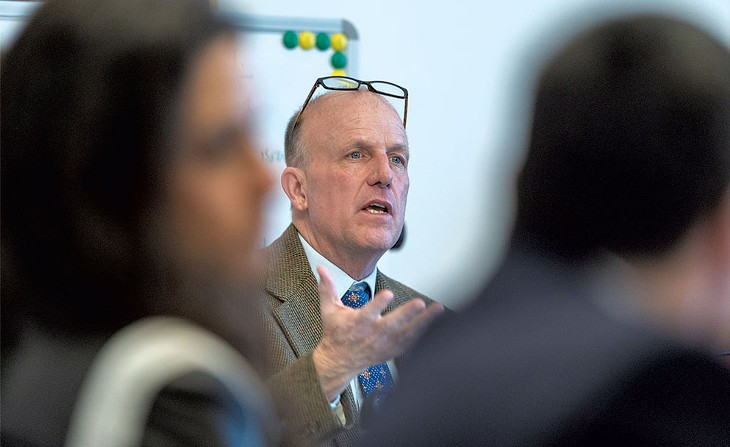
- Jeb Wallace-Brodeur
- Rep. Peter Conlon
"It continually hampers long-term planning as people sit by and say, 'Oh, my God, what if they find PCBs?' before we move ahead with whatever bigger construction plan they have," Conlon said.
Some questions should be answered before testing proceeds, he said. For example, should aging schools be required to test for and remediate PCBs when they only have a few years of use remaining? His proposed legislation, to pause the testing, would use the task force in Gulick's Senate bill to examine the program and determine whether it should be redesigned — or shelved for good.
"This PCB testing program essentially was created without a clear path forward," Conlon said. "And at the same time, we're trying to have a much more strategic look at our school construction in general, and the two, I feel, can't go on in their own silos."
The House Education Committee voted last Friday to move Conlon's legislation forward. The measure would allow any PCB testing currently under way to continue, and the state would cover expenses stemming from PCB mitigation or remediation thus far. The bill would also earmark as much as $16 million to defray the costs of PCB abatement at Burlington High School.
"I think there's a strong argument to be made that this $190 million rebuild of Burlington isn't 100 percent of their own making," Conlon said, suggesting that state-set PCB levels are partly to blame for the situation.
Gulick declined to comment on the House bill. But, like Conlon, she wants the state to take responsibility for what happened in the Queen City.
"It was so disheartening when the level was at 15 nanograms per cubic meter back when Burlington was first examined. That number was so incredibly low," Gulick said. "Sadly, there has been no acknowledgment of wrongdoing or mistakes made, and there's been no attempt to try to speak to the harm caused."
If enough House members vote for Conlon's bill, it would go to the Senate.
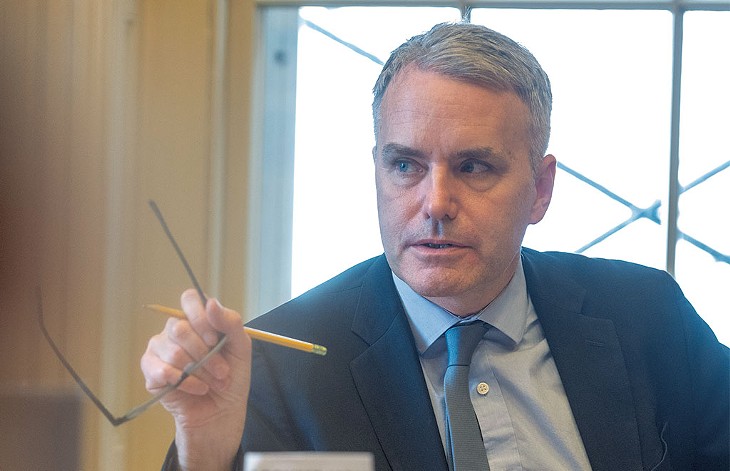
- Jeb Wallace-Brodeur
- Sen. Brian Campion
Senate Education Committee chair Campion acknowledges that there are still important questions to hash out this legislative session when it comes to the specifics of funding the PCB program. But, he said, that doesn't mean the program should be put on hold.
"I mean, what if the next school has a dangerous level and kids are literally going to school every day?" he said.
Sen. Baruth said he agreed that a pause doesn't make sense, noting that the testing program was designed to root out toxins that impact kids' health.
"We need that data," he said. "Are there other schools like Burlington that have extremely elevated counts?"
Baruth said the state should "very substantially" help communities that are dealing with PCB contamination but declined to specify whether school districts should be required to cover some percentage of the cost.
Officials in the Agency of Education and Department of Health are also against a testing pause.
"PCBs are a health concern for students, teachers, and other school community members, and pausing testing does not reduce or remove the risk," Health Commissioner Levine said in his statement. "We plan to continue our work with schools — and the legislature — to address this complex situation, however delaying testing seems counterintuitive to our shared goal."
What Are PCBs?
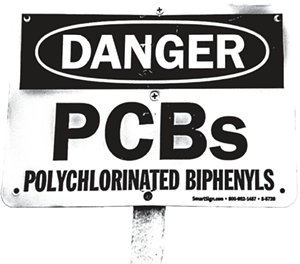
PCBs are polychlorinated biphenyls, chemicals that were manufactured starting in 1929 for use in products such as electrical equipment, televisions and refrigerators. They were common in window caulk, tile glue, paint and fluorescent light ballasts in buildings constructed in that era. After concerns about the environment and public health emerged, the United States banned importing and manufacturing PCBs in 1979. PCBs are considered toxic and are probable human carcinogens.
People can be exposed to PCBs by eating foods such as meat or fish that contain the chemicals, by skin contact, or by breathing indoor air in older buildings constructed with materials that contain the chemicals.
Source: National Oceanic and Atmospheric Administration and the U.S. Environmental Protection Agency
How'd we get here?
A PCB timeline
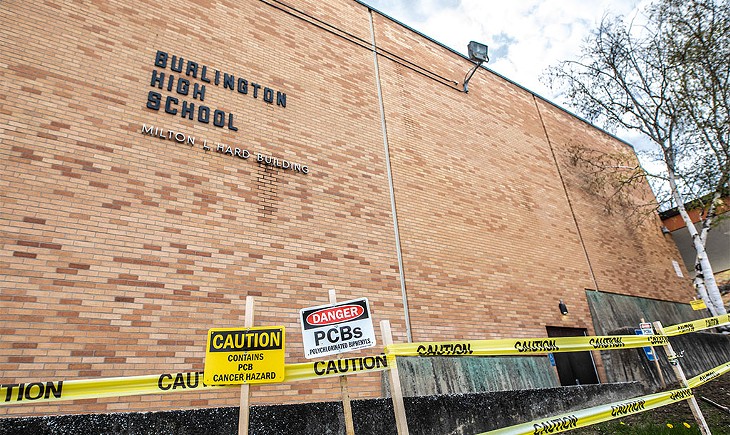
- File: Luke Awtry
- Burlington High School
- November 17, 2020: Burlington school commissioners vote to lease the former downtown Macy's department store as a temporary school for three and a half years while the district decides what to do.
- Fall 2020: In advance of a planned $70 million renovation of Burlington High School, environmental tests detect airborne PCBs. The findings exceed Vermont's very low "screening level." Students are already attending classes remotely due to the pandemic.
- Spring 2021: Vermont legislators approve spending $4.5 million to test for PCBs statewide in schools that were constructed before 1980.
- May 4, 2021: The Burlington School Board votes to abandon the PCB-contaminated high school.
- November 2, 2021: After considering various sites, the Burlington School Board votes to build a new high school on the old campus off North Avenue.
- November 2021: The Vermont Department of Health establishes "school action levels" that, when discovered, require steps to identify the source of PCBs and remediate.
- February 2022: Shortly before statewide testing is to begin, the health department releases new "immediate school action levels" for PCBs that indicate when a room is not usable. The standards are more restrictive than federal guidelines.
- Spring 2022: The legislature allocates $32 million from the education fund surplus to pay for PCB remediation in schools.
- June 2022: Statewide PCB testing commences.
- August 2022: The first actionable PCB results come back from Cabot School and Brattleboro's Oak Grove.
- October 2022: The Vermont Emergency Board approves $2.5 million in funds to be released for PCB mitigation in schools — with the state paying 80 percent and schools paying 20 percent. To date, no funds have been released to schools.
- October 2022: Two former Burlington High School educators sue PCB-maker Monsanto, saying exposure to the chemicals led to serious health problems.
- December 2022: The Burlington School District sues Monsanto, alleging that the company encouraged customers to use PCB mixtures in construction materials, despite known health risks.
- March 2023: A bill to pause the state testing program is introduced in the Vermont House.
- What's Next?: Testing has begun, and data has been returned for 22 schools. Eight of them had at least one sample that exceeded school action levels. In all, approximately 320 schools must be tested by July 2025, though officials have indicated that they may ask for more time — and more money — for testing.
How Much Is Too Much?
PCB standards in Vermont
Federal and Vermont officials provide guidance for exposure to airborne PCBs in schools. Because they consider the potential effects over time, figures are set by grade level or age. Here's a look at how they compare.
For a decade, Vermont has had a screening level of 15 nanograms per cubic meter, which the Vermont Department of Health says is "the chemical concentration below which no additional actions are recommended." (A nanogram is a billionth of a gram.)
The figure is so low, state officials acknowledge, that it is comparable to the background level of PCBs in the air.
These U.S. Environmental Protection Agency exposure levels for evaluating PCBs in schools are not "bright line" or "not-to-exceed" criteria, the agency cautions, but are instead meant to guide thoughtful evaluations.
Ages: Nanograms/cubic meter
- 1-3: 100
- 3-6: 200
- 6-12: 300
- 12-15: 500
- 15-19: 600
- 19-adult: 500
Source: U.S. Environmental Protection Agency
In November 2021, the Vermont Department of Health established "school action levels." When reached, the state requires that the source of the PCBs be identified and remediated.
Age/Grade: Nanograms/cubic meter
- Pre-K: 30
- K-6: 60
- 7-adult: 100
In February 2022, the Vermont Department of Health released "immediate action levels" for airborne PCBs that are triple the school action levels. Students and staff cannot occupy spaces with these amounts of PCBs:
Age/grade: Nanograms/cubic meter
- Pre-K: 90
- K-6: 180
- 7-adult: 300


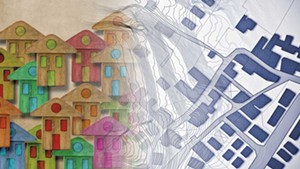











Comments
Comments are closed.
From 2014-2020, Seven Days allowed readers to comment on all stories posted on our website. While we've appreciated the suggestions and insights, right now Seven Days is prioritizing our core mission — producing high-quality, responsible local journalism — over moderating online debates between readers.
To criticize, correct or praise our reporting, please send us a letter to the editor or send us a tip. We’ll check it out and report the results.
Online comments may return when we have better tech tools for managing them. Thanks for reading.